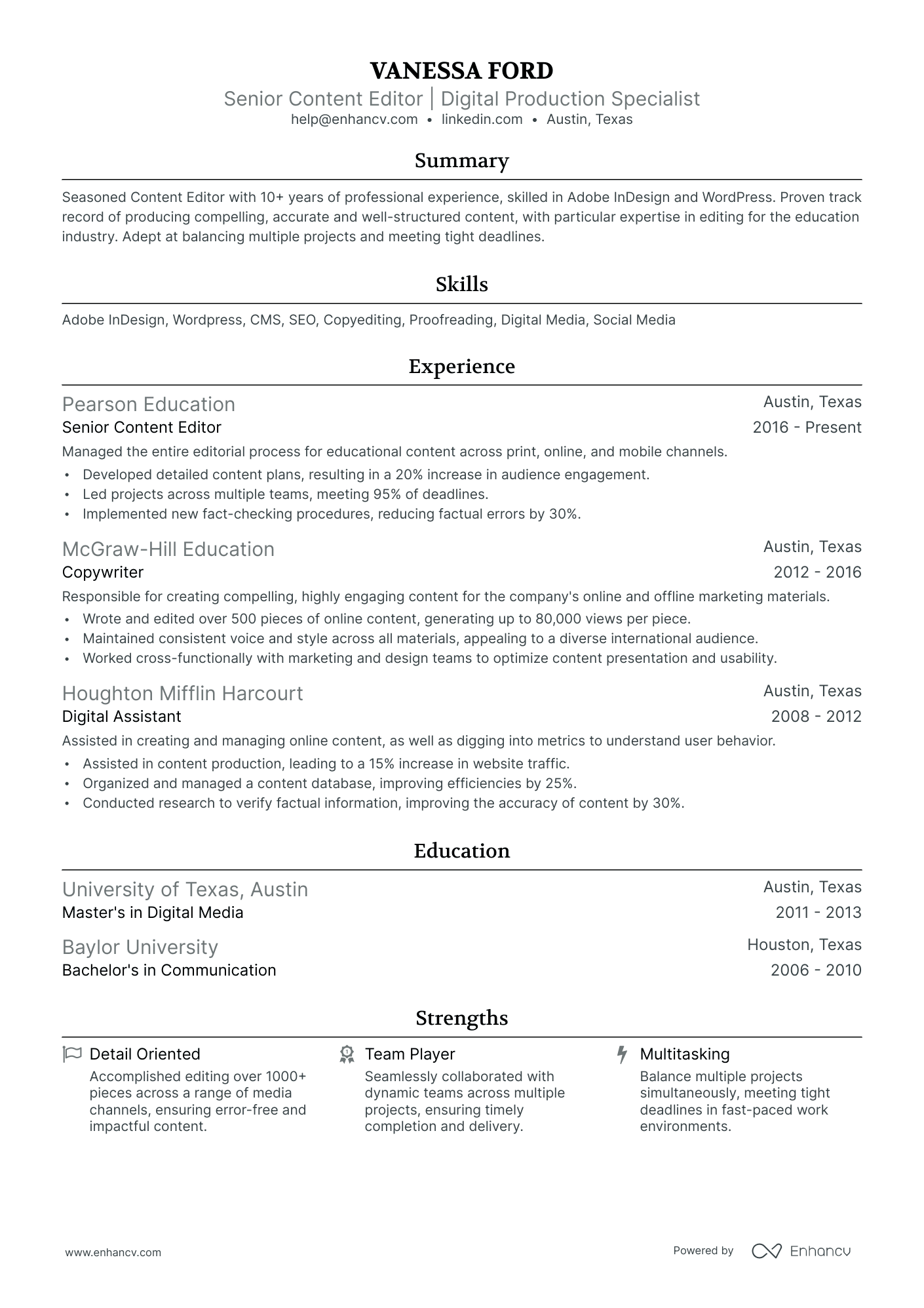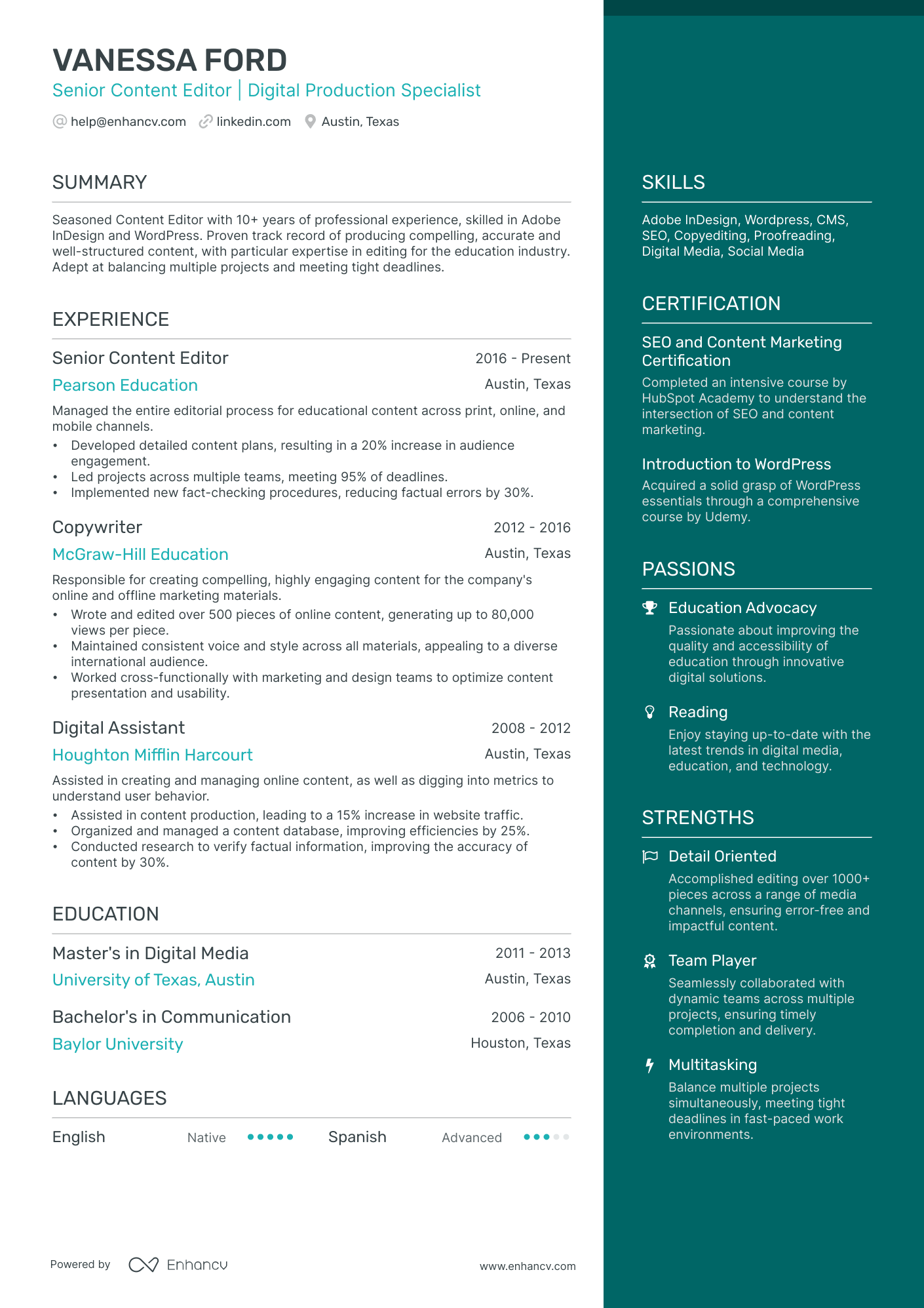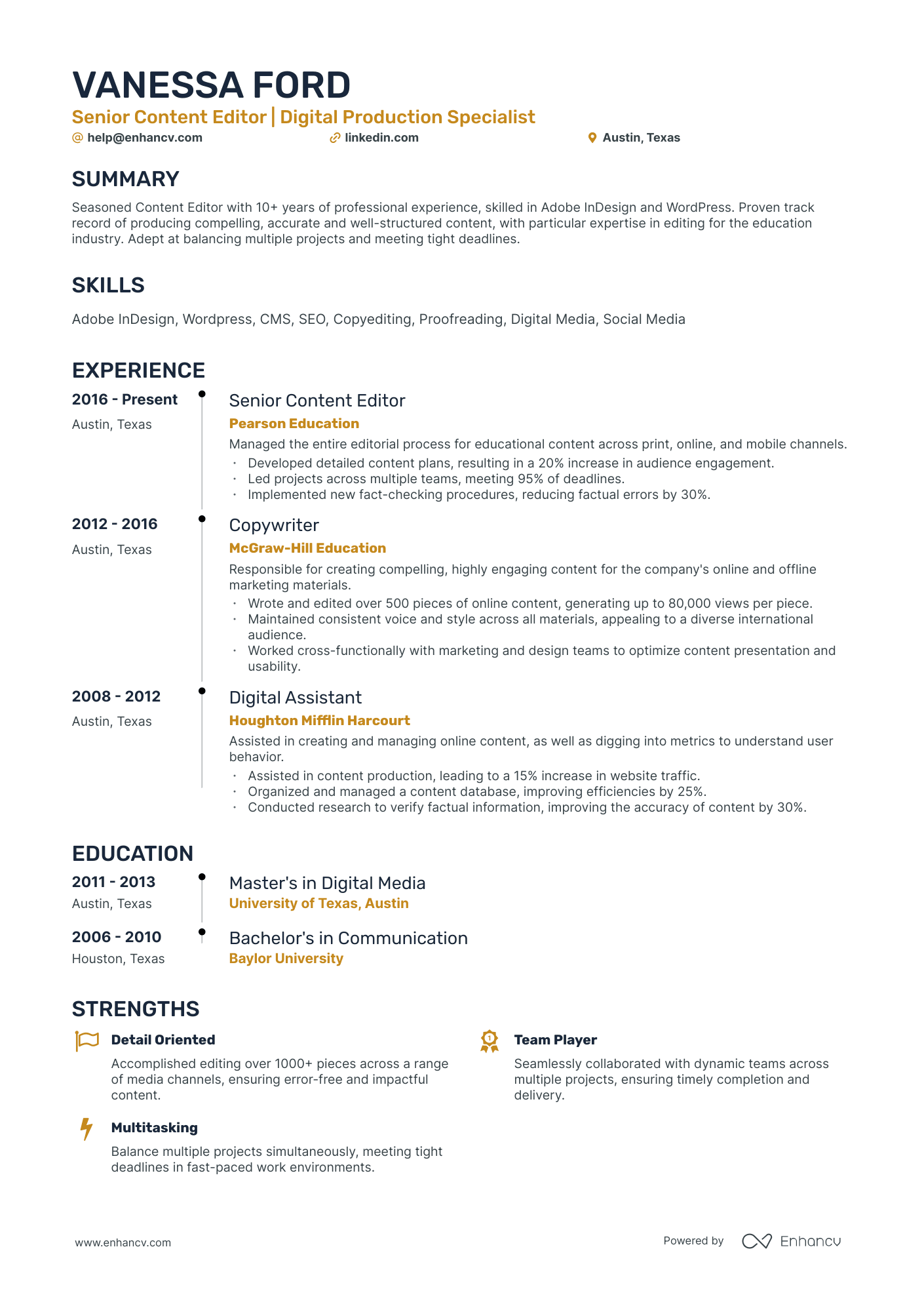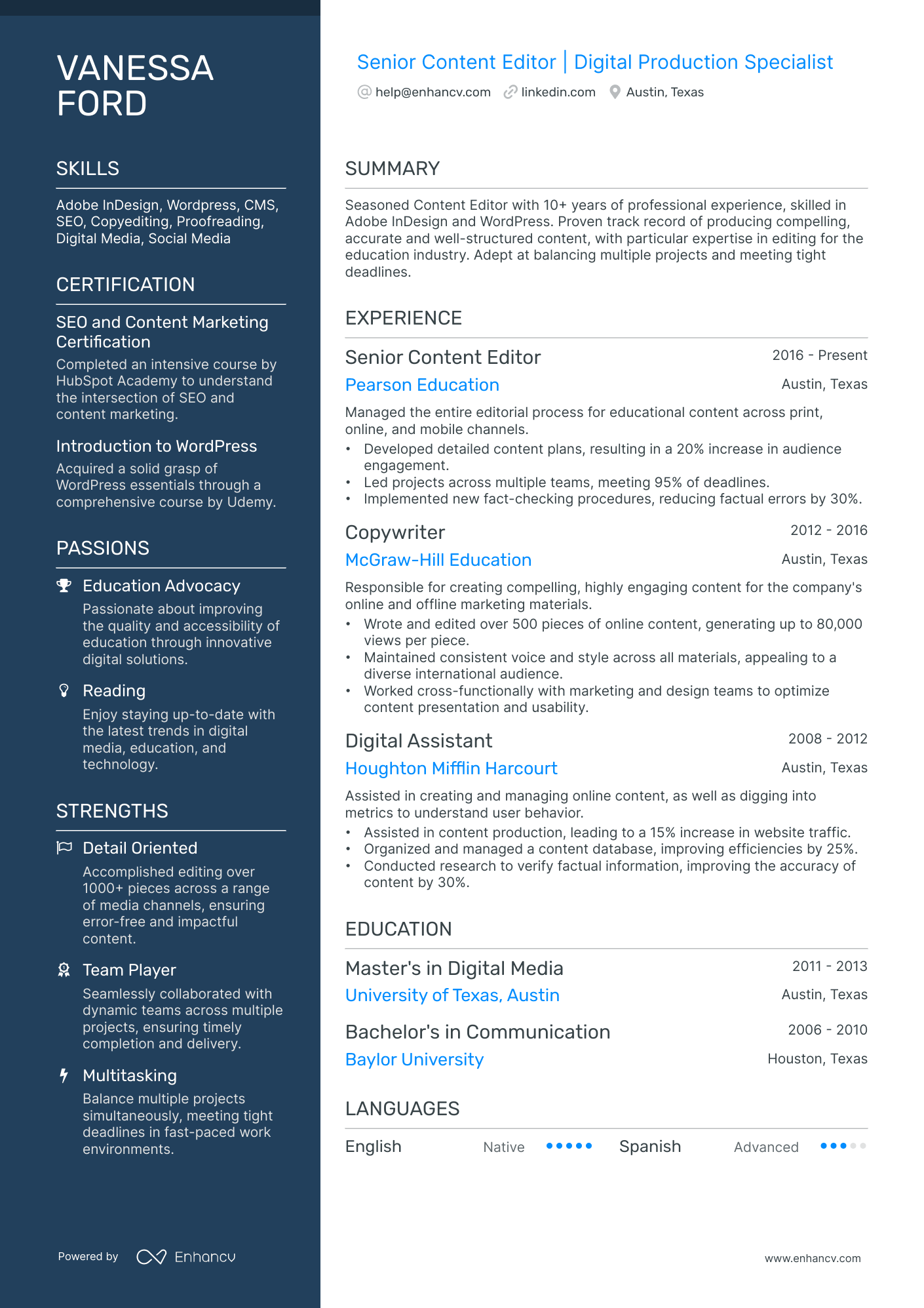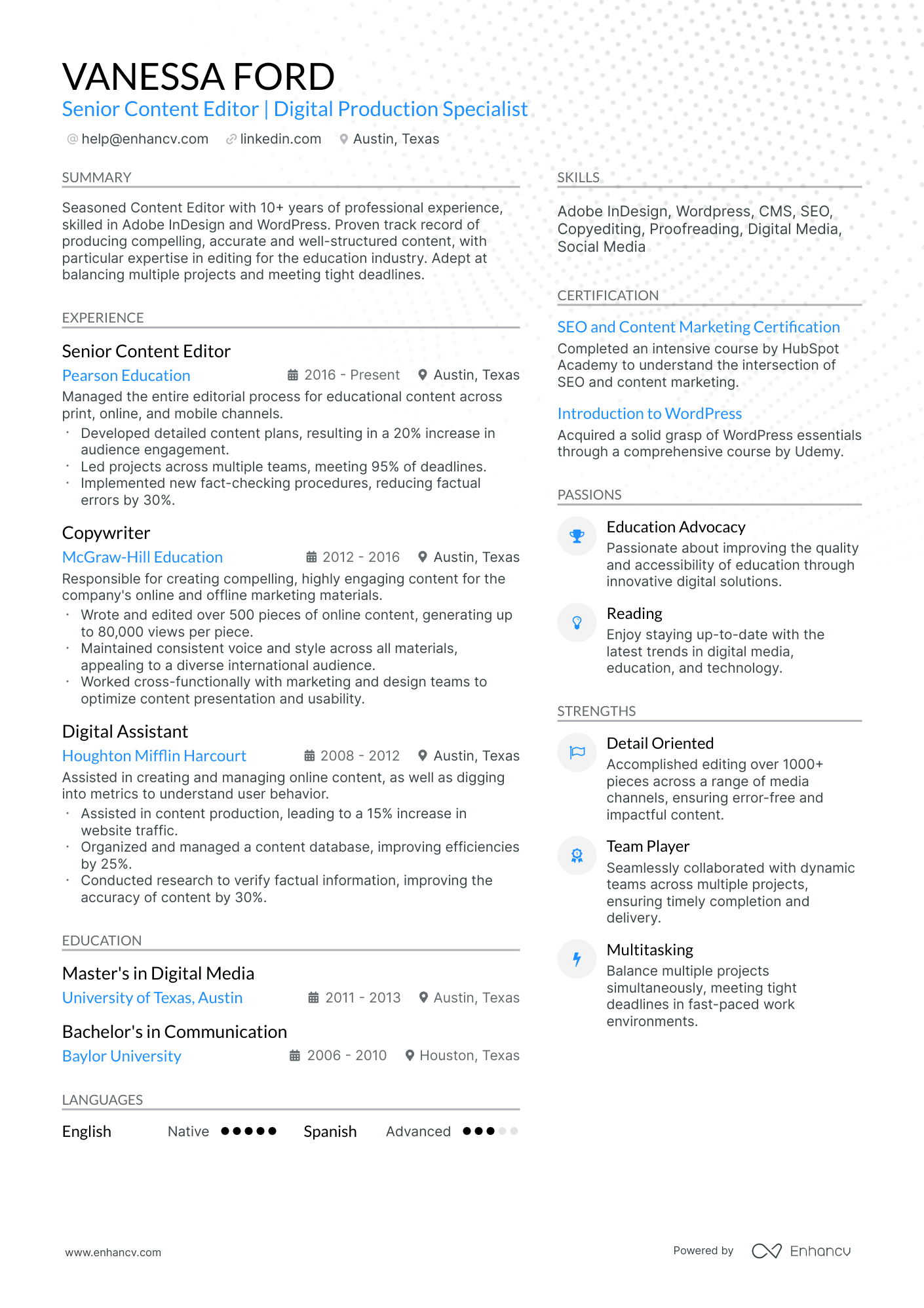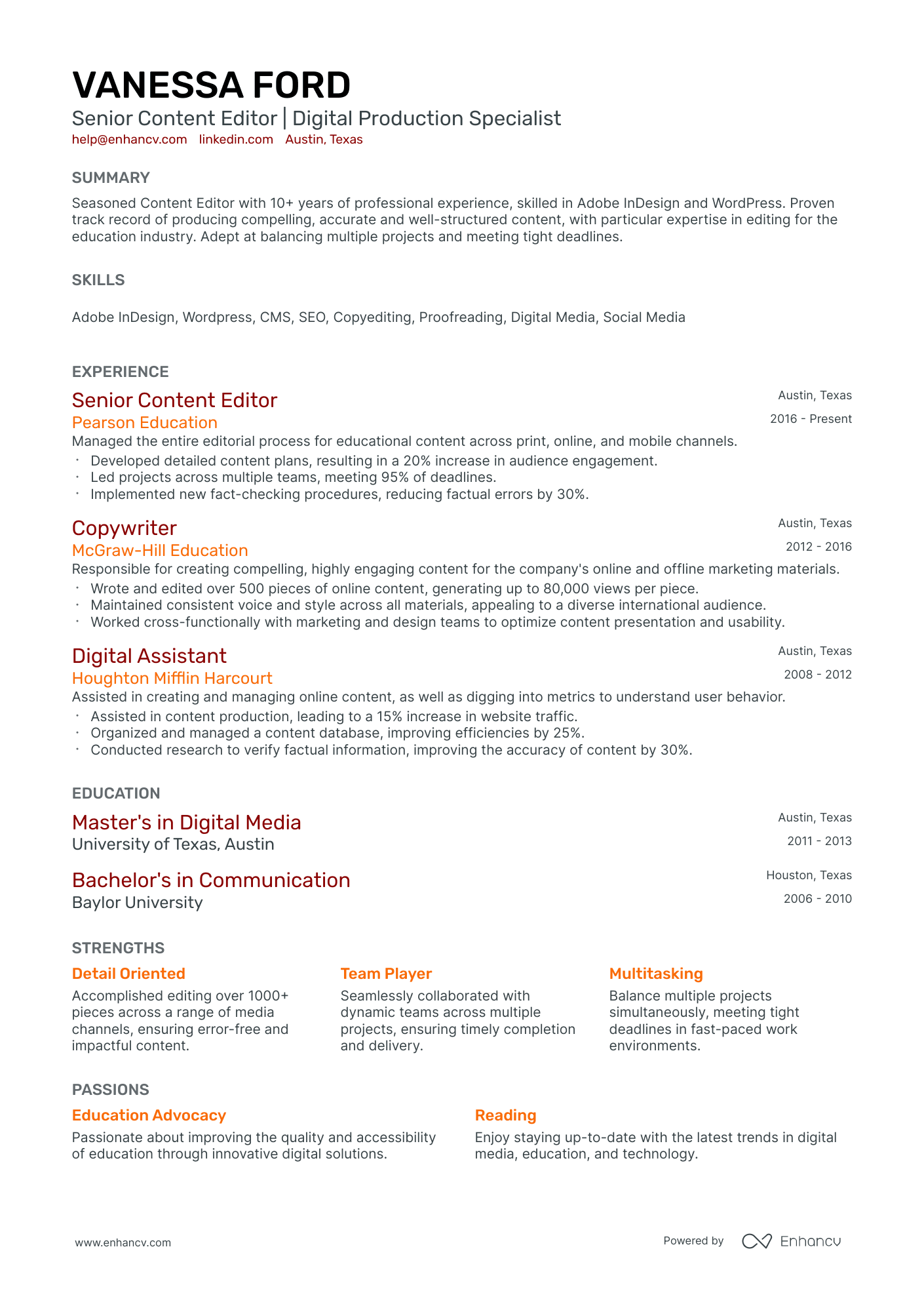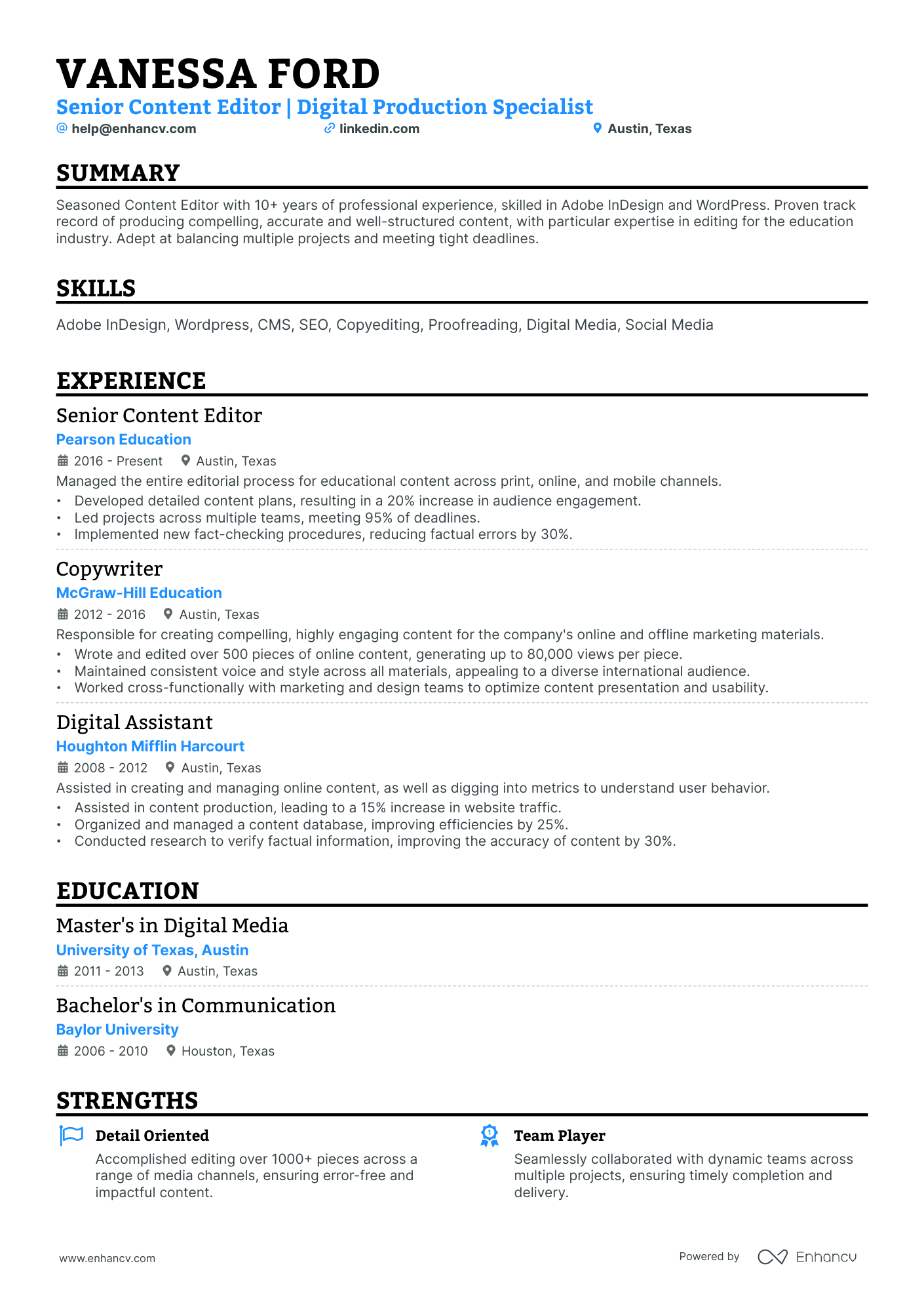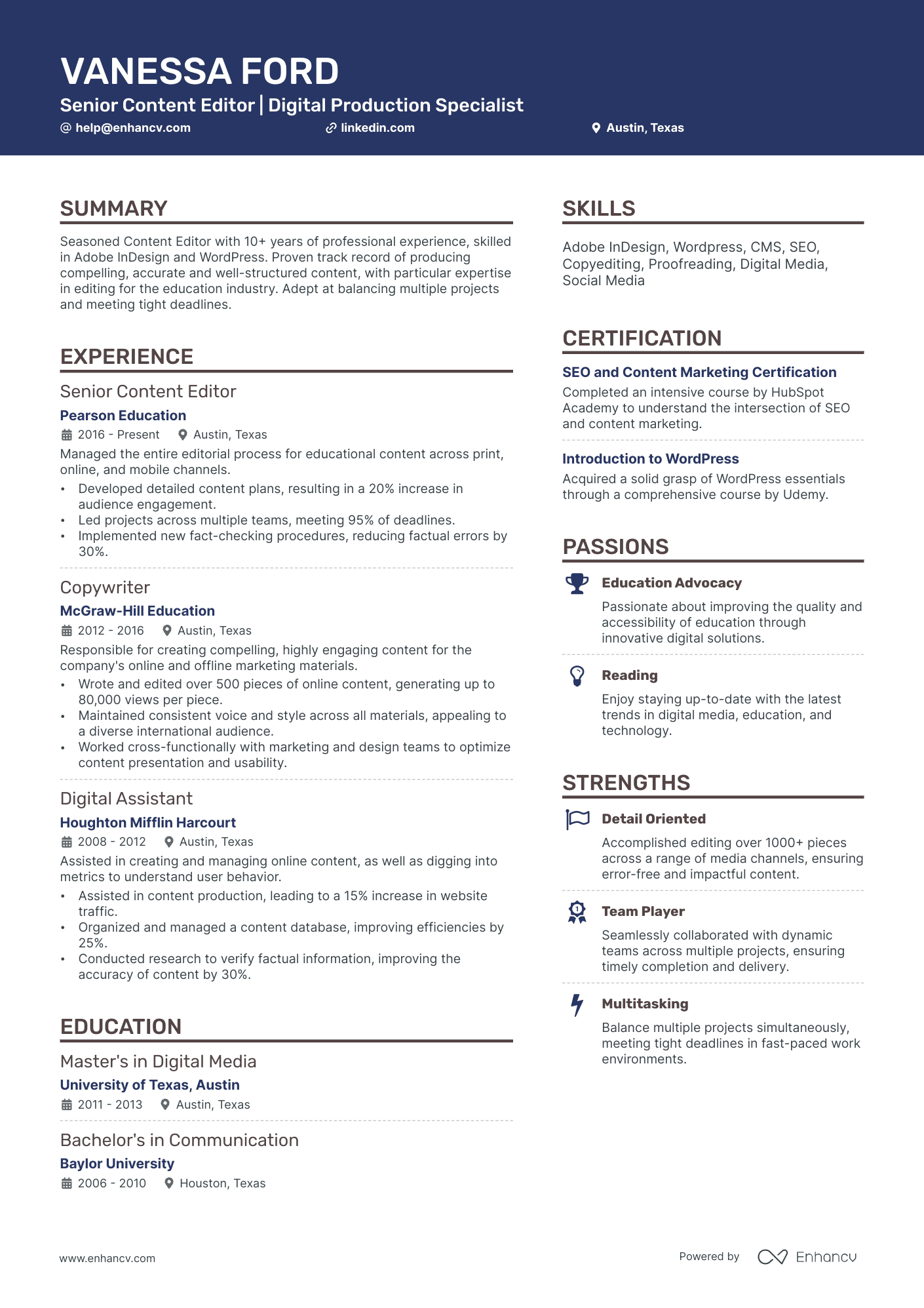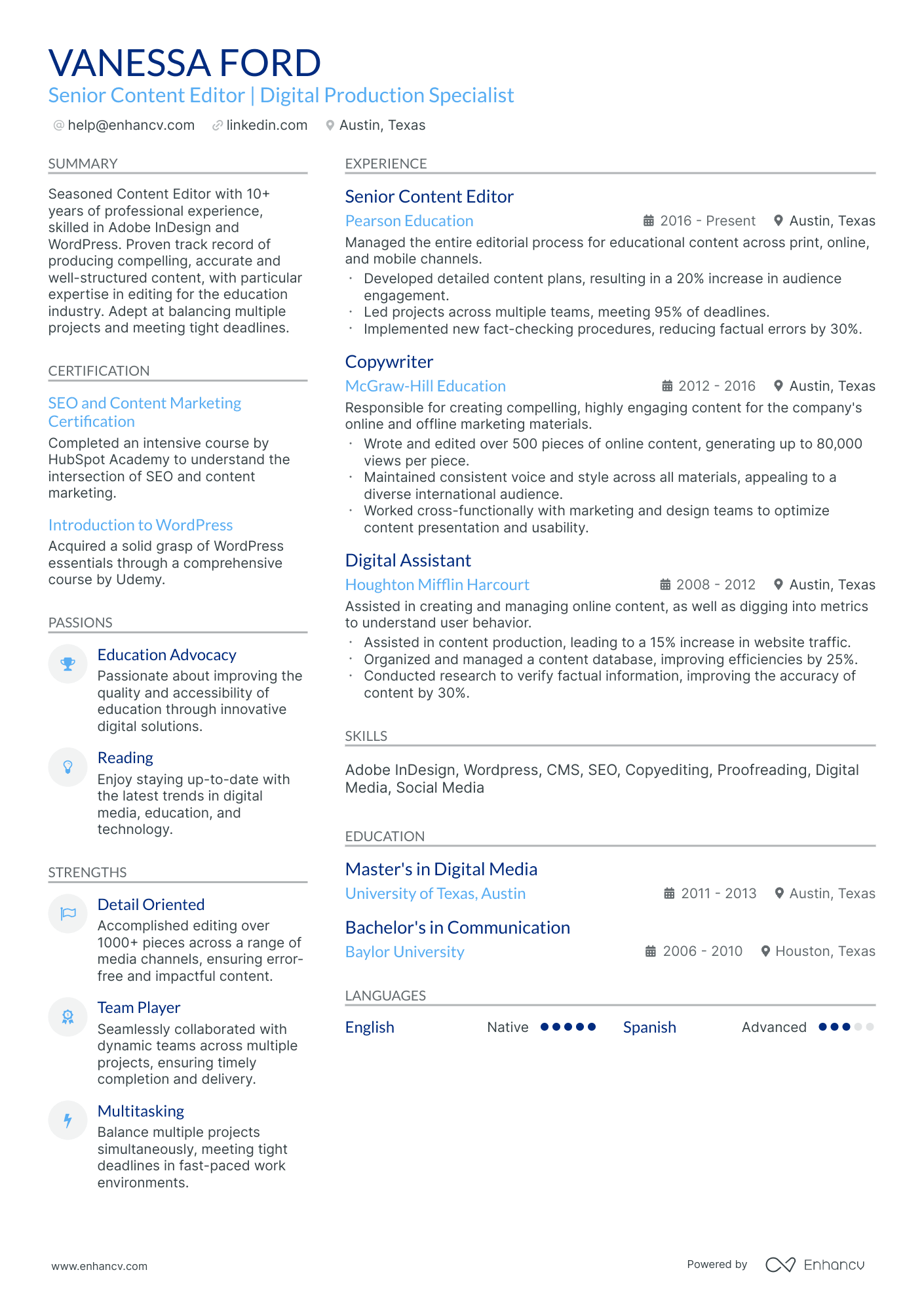Content editors often struggle to effectively showcase their diverse skills such as writing, editing, SEO management, and content strategy in a coherent manner on their resume. Our guide can assist by providing specific templates and actionable tips on how to structure a resume, helping content editors highlight their multifaceted skill set in a clear, compelling way.
Our content editor guide will help you perfect your resume by explaining you how to:
- Alight your content editor resume with the role you're applying for ensuring it will be read by the applicant tracking system.
- Tailor your specific content editor experience to get the attention of recruiters.
- List your relevant education to impress hiring managers.
- Discover job-winning content editor professional resume examples to inspire writing yours.
Recommended reads:
Structuring your content editor resume to engage recruiters
The presentation of your content editor resume is crucial.
Is it easy to read and well-organized? Does it have a logical flow?
Avoid overwhelming recruiters with a cluttered document. Instead, follow these best practices to ensure a consistent resume format:
- Include a header in the top third of your content editor resume for easy contact and quick access to your professional portfolio or LinkedIn profile.
- In the experience section, start with your most recent role and detail your career in a reverse-chronological order.
- Unless specified, submit your resume as a PDF to maintain its layout. Some companies might request other formats.
- If you're applying for a senior position and have over a decade of relevant experience, a two-page content editor resume is acceptable. Otherwise, aim for a single page.
Tailor your resume format to the job market – a Canadian resume, for example, might differ in layout.
Upload your resume
Drop your resume here or choose a file. PDF & DOCX only. Max 2MB file size.
Pro tip
At the end of the day, recruiters care most about how easily they can scan and read your resume layout. Unless you're aiming for a role in a creative field, it might be best to stick with a straightforward layout and format. Instead, put your energy into showcasing your experience.
Essential sections for a standout content designer resume:
- The top section should combine your header—with accurate contact details—and a concise summary or objective that encapsulates your professional achievements.
- An experience section that chronicles your career trajectory and how each role contributed to your professional development.
- Highlight significant achievements that demonstrate the practical application of your skills, leading to tangible results.
- Include industry-recognized certifications to underscore your technical proficiency or interpersonal skills.
- Detail your educational background relevant to the field.
What recruiters want to see on your resume:
- Proven experience in creating, editing and promoting written and visual content.
- Excellent command over language and grammar with the ability to produce clean, factual, and engaging copy.
- Strong knowledge of content management systems (CMS) and familiarity with SEO best practices.
- Ability to work under tight deadlines without compromising on quality.
- Demonstrated understanding of target audience and the type of content that appeals to them.
Recommended reads:
How to create the cornerstone experience section of your content editor resume
A meticulously crafted content editor resume experience section is a recruiter's delight. This segment not only responds to job criteria but also throws light on your technical expertise and character.
To craft an impactful experience section:
- Highlight roles directly related to the position in question.
- Pair each role or task with a metric that quantifies your achievements.
- Chronicle your content editor career progression, illustrating your dedication and growth in the domain.
- For each role, elucidate challenges faced, strategies employed, and the broader organizational impact.
Examine the following content editor samples to discern how seasoned professionals have articulated their experiences:
- Led content editing for a leading media company, ensuring accuracy, clarity, and adherence to style guidelines.
- Developed and implemented an editorial calendar, resulting in a 20% increase in content production and improved efficiency.
- Collaborated with cross-functional teams, including writers, designers, and marketers, to create engaging and SEO-optimized content.
- Conducted thorough research on industry trends and competitor analysis to inform content strategy and maintain a competitive edge.
- Managed a team of content editors, providing guidance, feedback, and training to enhance their skills and maintain quality standards.
- Edited and proofread web content for a digital marketing agency, ensuring grammatical accuracy and consistency.
- Optimized content for search engines, resulting in a 30% increase in organic traffic and higher rankings on major search engines.
- Collaborated with clients to understand their brand voice and incorporate it into the content for various digital channels.
- Managed multiple projects simultaneously, meeting strict deadlines and maintaining high-quality standards.
- Implemented editorial guidelines and style standards to maintain consistency across all client deliverables.
- Reviewed and edited articles for a renowned online publication, ensuring accuracy, clarity, and adherence to editorial standards.
- Developed and executed a content strategy that focused on increasing audience engagement and driving website traffic.
- Collaborated with writers to enhance their content and improve readability, resulting in a 25% increase in reader satisfaction.
- Managed social media accounts, creating and scheduling engaging posts that increased follower engagement by 40%.
- Conducted keyword research and implemented SEO techniques to optimize content for improved visibility and organic reach.
- Coordinated the editorial process for a global e-learning platform, overseeing content creation, editing, and publication.
- Developed and maintained style guides and content standards, ensuring consistent branding and messaging across all courses.
- Collaborated with subject matter experts to create engaging and instructional content that met learning objectives.
- Managed localization projects, working with translation teams to adapt content for international markets.
- Conducted user testing and gathered feedback to iterate on content and improve the overall learning experience.
- Edited and proofread technical documents and user manuals for a software development company.
- Collaborated with developers and product managers to ensure accuracy and clarity of technical content.
- Standardized documentation templates and style guidelines, resulting in improved consistency and ease of use.
- Created video tutorials and step-by-step guides to assist users in understanding complex software functionalities.
- Participated in QA testing to identify usability issues and provide feedback for product improvement.
- Managed the editorial process for a leading fashion magazine, overseeing content creation from ideation to publication.
- Collaborated with photographers, stylists, and models to produce visually appealing fashion editorials and photo shoots.
- Developed creative concepts and themes for each issue, resulting in increased reader engagement and positive feedback.
- Implemented social media strategies to promote magazine content and grow online presence, resulting in a 50% increase in followers.
- Conducted interviews with industry professionals, creating insightful articles that contributed to the magazine's reputation.
- Edited and curated content for a popular lifestyle blog, ensuring high-quality writing and engaging storytelling.
- Managed a team of freelance writers, providing guidance and feedback to maintain consistent quality standards.
- Developed partnerships with brands to create sponsored content that aligned with the blog's audience and brand values.
- Performed keyword research and implemented SEO techniques to optimize blog posts for increased organic traffic.
- Analyzed website analytics and user behavior data to identify content trends and inform content strategy.
- Edited and proofread educational textbooks and study materials for an educational publishing company.
- Collaborated with authors and subject matter experts to ensure accuracy and educational effectiveness of content.
- Developed supplementary materials, such as quizzes and activities, to enhance student engagement and comprehension.
- Managed multiple projects with competing deadlines, coordinating with design and production teams to meet publishing schedules.
- Reviewed market feedback and conducted competitor analysis to align content with evolving educational standards.
- Lead a team of content editors for a renowned news website, ensuring editorial excellence and timely publication.
- Develop and implement editorial guidelines and style standards to maintain consistency and uphold journalistic integrity.
- Collaborate with journalists and reporters to shape news stories, providing valuable feedback and enhancing their writing skills.
- Oversee content optimization for search engines, resulting in increased organic traffic and higher rankings on major search platforms.
- Stay up-to-date with industry trends and technological advancements to drive innovation in digital journalism.
- Edited and proofread marketing materials, including brochures, websites, and promotional emails, for a creative agency.
- Collaborated with designers and marketers to ensure the alignment of content with brand messaging and visual identity.
- Developed compelling copy for various marketing campaigns, resulting in increased customer engagement and lead generation.
- Conducted market research and competitor analysis to identify target audience needs and develop effective communication strategies.
- Implemented A/B testing to optimize marketing content and improve conversion rates.
The following content includes information from "O*NET OnLine" by the U.S. Department of Labor, Employment and Training Administration (USDOL/ETA). Used under the CC BY 4.0 license. The data represents the top responsibilities present on the task lists for content editor professionals.
Top Responsibilities for Content Editor:
- Read copy or proof to detect and correct errors in spelling, punctuation, and syntax.
- Verify facts, dates, and statistics, using standard reference sources.
- Read, evaluate and edit manuscripts or other materials submitted for publication, and confer with authors regarding changes in content, style or organization, or publication.
- Develop story or content ideas, considering reader or audience appeal.
- Prepare, rewrite and edit copy to improve readability, or supervise others who do this work.
- Oversee publication production, including artwork, layout, computer typesetting, and printing, ensuring adherence to deadlines and budget requirements.
- Write text, such as stories, articles, editorials, or newsletters.
- Confer with management and editorial staff members regarding placement and emphasis of developing news stories.
- Plan the contents of publications according to the publication's style, editorial policy, and publishing requirements.
- Review and approve proofs submitted by composing room prior to publication production.
Quantifying impact on your resume
<ul> <li>Include the number of articles, blogs, or pieces of content you've edited, to demonstrate your extensive experience.</li> <li>List the percentage increase in reader engagement or views that resulted from your editing, to show your impact on audience interest.</li> <li>Mention any changes in SEO performance such as a rise in search engine rankings or organic traffic due to your work, indicating your understanding of online visibility strategies.</li> <li>Quantify the number of editorial staff you've managed or trained, if applicable, to exhibit leadership and team management skills.</li> <li>Showcase your ability to work under pressure by mentioning the highest number of pieces you have edited within tight deadlines.</li> <li>If you've worked with international teams or on foreign content, specify the number of languages you have edited in or the number of countries your content reached, to highlight your adaptability and global reach.</li> <li>Indicate the size of the largest project or campaign you've worked on, such as the total budget or the number of people involved, to reflect your ability to handle significant responsibilities.</li> <li>Detail any reduction in errors or increase in content quality using percentage, showing your attention to detail and commitment to excellence.</li>
Writing your content editor experience section without any real-world experience
Professionals, lacking experience, here's how to kick-start your content editor career:
- Substitute experience with relevant knowledge and skills, vital for the content editor role
- Highlight any relevant certifications and education - to showcase that you have the relevant technical training for the job
- Definitely include a professional portfolio of your work so far that could include university projects or ones you've done in your free time
- Have a big focus on your transferable skills to answer what further value you'd bring about as a candidate for the content editor job
- Include an objective to highlight how you see your professional growth, as part of the company
Recommended reads:
Pro tip
Use the SOAR (Situation - Action - Results) method for each of your content editor experience bullets. Reflect on specific challenges you've addressed, the actions you took, and the outcomes. This approach also preps you for potential interview questions.
Essential content editor resume skills
When recruiters review content editor resumes, they're looking for a mix of technical know-how and personal attributes.
Technical skills demonstrate your proficiency in specific tools or tasks. They indicate if you're ready to jump into the role or if you'll need extensive training.
On the other hand, soft skills reflect your interpersonal abilities. They show how you'll fit into a team or company culture.
To effectively present these skills on your resume:
- Design a skills section that highlights both your technical and interpersonal strengths.
- Provide examples where you've applied these skills, such as projects or tasks.
- For soft skills, describe situations where they've been crucial to your success.
- Use metrics, like improved efficiency or positive feedback, to validate your skills.
For inspiration, explore the preferred skills of leading content editor professionals.
Top skills for your content editor resume:
Content Management Systems (CMS)
SEO Optimization
HTML/CSS
Adobe Creative Suite
Google Analytics
WordPress
Social Media Management Tools
Plagiarism Detection Software
Photo Editing Software
Microsoft Office Suite
Attention to Detail
Time Management
Communication Skills
Critical Thinking
Creativity
Collaborative Mindset
Adaptability
Problem-Solving
Organizational Skills
Project Management
Next, you will find information on the top technologies for content editor professonals from "O*NET OnLine" by the U.S. Department of Labor, Employment and Training Administration (USDOL/ETA). Used under the CC BY 4.0 license.
Top technologies for Content Editor’s resume:
- Google Docs
- Microsoft Word
- WordPress
- Adobe InDesign
- Microsoft Publisher
Pro tip
When detailing your skills, always back them up with tangible evidence, be it quantifiable results or certifications.
Content editor resume: certifications and education
Boost your content editor resume by:
- Featuring recent and relevant certificates.
- Listing basic details: certificate name, school, and dates.
- If you lack experience, highlight skills from your education.
- Only include valid license numbers if needed.
Job ads often list desired education and certificates. Match these with top industry certificates.
Best certifications to list on your resume
Pro tip
Remember, certifications can be woven into various resume sections, like experience or summary. Detail how a particular certification enhanced your performance or opened new opportunities.
Recommended reads:
best practices for your content editor resume summary or objective
How do you know if you should include a resume summary or a resume objective?
- Resume summaries are ideal for content editor professionals with more experience, who'd like to give a quick glimpse of their biggest career achievements in the top one-third of their resumes.
- On the other hand, resume objectives serve as a road map to the applicant's aspirations. Candidates use the objective as the North Star of their career (or, how they see themselves in the role in the next few years).
Both could be the perfect fit for your content editor resume, depending on your experience.
Here's how candidates for the content editor job structure their summaries and objectives.
Resume summary and objective examples for a content editor resume
Optimize your resume summary and objective for ATS
Drop your resume here or choose a file.
PDF & DOCX only. Max 2MB file size.
Additional sections to elevate your content editor resume
To further differentiate your content editor application, consider adding sections like:
- Publications
- Projects
- Awards
- Hobbies (only if they align with the job or showcase relevant skills).
These sections can further demonstrate your technical acumen and interpersonal skills.
Key takeaways
- Your resume's layout should be both visually appealing and content-rich.
- Emphasize achievements that resonate with the job's requirements.
- Detail your skills, both technical and interpersonal, with real-world examples.
- Ensure the top section of your resume provides a clear snapshot of who you are and what you offer.
- When detailing experience, focus on tasks, actions, and their outcomes.
